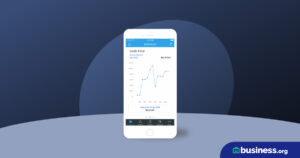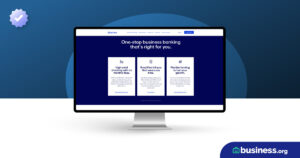💸 See if your business qualifies for a tax credit worth up to $26k per employee. 📞 Call Now: 855-979-9597
What Is Peer-to-Peer Lending?
We are committed to sharing unbiased reviews. Some of the links on our site are from our partners who compensate us. Read our editorial guidelines and advertising disclosure.
Remember what buying a car used to be like? Spending hours wandering around a dusty lot while a commission-hungry sales bro in coffee-stained Dockers yammers on about mileage, undercoating, and the sweet toaster oven he’s going to throw in with the deal after he “talks to his manager”? Hello online auto shopping; buh-bye bro.
Peer-to-peer (P2P) lending works in a similar fashion, bypassing traditional banks and credit unions just as online car sellers forgo the lot and those inexplicable blow-up wavy-arms dancers. With no bank in the way, investors work directly with borrowers in P2P lending, and transactions are conducted strictly over the internet. There are no free calendars or pens, but you also won’t have to deal with any of that awkward “human interaction” over a banker’s desk.
Just like buying a car online, peer-to-peer lending involves risk, so you should know what you’re getting into before going the P2P route for your small business. Take a ride with Business.org as we break down peer-to-peer lending.
P2P lending
What is peer-to-peer lending and how does it work?
Peer-to-peer lending1 takes banks and credit unions out of the equation, creating a direct line between investors and borrowers through a “crowdlending” platform (you’ve probably heard of Lending Club and Prosper, two of the most popular US P2P lenders). P2P is conducted almost exclusively online, meaning borrowers have access to a wider swath of potential lenders than what’s available around the block. The convenience and array of choices are attractive to borrowers; investors can make back more money without having to give a cut to a bank.
While investors usually charge higher interest rates than banks, borrowers don’t pay extra fees to cover the costs of maintaining a physical bank (buildings, other branches, employees, security, computers, etc.), so the overall effect on a P2P loan’s final price tag is negligible. Peer-to-peer loans tend to total $2,000–$35,000 with 3- to 5-year repayment terms, though some can go up to $100,000 and higher—since P2P loans are a relatively new US financing development, averages are still being established.
Like standard bank loans, a personal credit score in and above the 600s is the standard for peer-to-peer loans—though there are options for borrowers with lower scores and less-than-favorable credit (more on this later). P2P lenders generally don’t charge application fees or tack on the extra charges that banks do, but they can deduct an origination fee from your loan total, typically between 1% and 5%. For example: If you have a $20,000 loan with a 2% origination fee, $400 will be deducted from your loan’s total off the top.
By signing up I agree to the Terms of Use and Privacy Policy.
Advantages of P2P lending for business
- Lower interest rates. While peer-to-peer loan rates may appear high on the surface, you won’t be paying the added fees for maintaining a physical bank and employees.
- Fewer restrictions. P2P investors generally don’t care about the purpose of a loan. Whereas banks usually refuse to give personal loans for business use, most peer-to-peer investors wouldn’t make the distinction.
- Simple application. The P2P loan process can be handled completely online—even third-party verification and document signing—through email or secure investor portals.
- Quick turnaround. Peer-to-peer loans can go from application to receipt of funds in a matter of days, as opposed to weeks or even months through a traditional bank or credit union.
- No personal contact. Face-to-face meetings with bankers can be uncomfortable experiences, even under the best of circumstances. The online nature of P2P lending eliminates the human factor (it’s not as dystopian as it sounds—think of how much other business you conduct via screens).
Disadvantages of P2P lending for business
- Few precedents. Though it’s growing fast, peer-to-peer lending is still a new financial business practice in the US and around the world, dating back as recently as 2005 (UK) and 2010 (US).
- Investor discretion. P2P loans are funded by an array of investors and businesses, and there’s a chance not all of them will be interested in your business or product, so you could fall short of your desired amount.
- Investor anonymity. Unlike a bank or credit union, it can be difficult or impossible to look up the standing and stability of peer-to-peer lenders—a problem if you like to know where your money’s coming from.
- Unrecoverable losses. Peer-to-peer business loans aren’t sponsored by the FDIC (Federal Deposit Insurance Corporation), so any losses incurred could be on you, not the investor. Read the fine print.
- Origination fees. We covered this cost of doing business with a P2P platform already and, even though it’s a minor factor, it’s still worth looking at. Determine if the cut they take will hurt your bottom line first.
Can you use P2P lending if you have bad credit?
Even before the financial crisis of the mid-2000s, traditional banks were typically chilly to applicants with bad credit. P2P is a warmer option if your credit score falls in the low 600s. Because peer-to-peer lending puts your loan request in front of a larger, more diverse pool of lenders, your chances of attracting investors who aren’t averse to risk are far greater.
Still, you’ll want to make sure that you have a low debt-to-income ratio, no past-due balances or delinquencies, less than 50% credit card balance, and a relatively modest loan request (even the most adventurous investors are wary of lending over $16,000 to bad-credit borrowers).
P2P lending vs. other business loans
Becoming a business and real estate P2P lender
Rather than seeking capital for yourself, you may want to expand your portfolio and become a peer-to-peer lender to businesses and consumers. As a P2P investor, you don’t have to provide full loan amounts—many peer-to-peer loans involve several parties providing a portion of the lump sum. These portions are called “notes,” where you can spread your investment money over fractions of several business or real estate loans, sometimes as little as $25. P2P lending platforms2 perform the administrative tasks for a small percentage, allowing you to collect payments on numerous loans simultaneously for little risk.
The takeaway
For convenience and bad-credit leniency, peer-to-peer loans are an attractive alternative to the usual bank or credit union routes. P2P lending platforms are proliferating quickly, and thousands of businesses are taking advantage of them every year with no sign of the trend cooling off. Online car sellers didn’t put auto lots and wavy-arms-dancer manufacturers out of business, and peer-to-peer lending likely won’t overtake brick-and-mortar banks, either—but, for borrowers and investors alike, it’s an exciting new capital vehicle worth taking for a spin.
Disclaimer
At Business.org, our research is meant to offer general product and service recommendations. We don't guarantee that our suggestions will work best for each individual or business, so consider your unique needs when choosing products and services.
Sources
- Good Financial Cents, “Peer-to-Peer Lending 101," April 21, 2022. Accessed July 1, 2022.
- Money Under 30, “Best Peer-to-Peer Lending Sites for Borrowers and Investors,” June 1, 2022. Accessed July 1, 2022.





